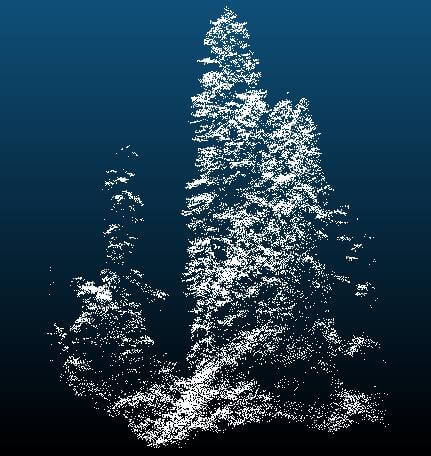Searching for the Tallest Second-Growth Trees

LiDar-generated image of a coast redwood. (Credit: Zane Moore)
By Madeleine Turner, Sempervirens Fund
A plane flies over the Santa Cruz Mountains and pummels the coast redwood treetops, which resemble a forest of imperfect romanesco broccoli, with lasers. Each laser bounces off its first contact—a tree or the forest floor—and contributes to a collection of data points. Those data points are then converted into a 3D model of the landscape.
This technique—called LiDAR—enables redwood researcher and UC Davis graduate student Zane Moore to scour the terrain from his computer. Moore is searching for the tallest second-growth redwood tree in the Santa Cruz Mountains.
After identifying which points hit the ground, Moore calculates the height of anything rising above the forest floor—namely coast redwoods. Moore also maps crown volume, which includes leaves and branches extending from the trunk—an indicator of forest productivity.
Moore says the resulting images look like pointillism art: White dots delineate the dimensions of trees against a black background, like ghostly 3D etchings.
To study the redwoods, Moore relies on data that was originally gathered by the National Oceanic and Atmospheric Administration in 2010. Until Moore began using the data for his own research, its full potential remained untapped: The agency had collected LiDAR data for the purpose of surveying topography—not trees.
Recently Moore discovered one 276-foot-tall, second-growth tree in the Forest of Nisene Marks State Park.
“There’s only a few other trees in that height class,” he said. “It’s currently the tallest [second-growth] known.”
The tree, however, isn’t an outlier. This particular grove contains taller-than-average trees. Most loom over 250 feet, and a handful stand merely a few inches shorter than the 276-footer. The grove is situated in a canyon, which means trees are vying for light, prompting them to grow taller, faster.
Under normal conditions, it can take 300 to 400 years for a coast redwood to reach 300 feet. Existing trees block out light and make survival difficult for younger, shorter trees. But after clear-cutting, the equation changes.
Before the start of the 20th century, timber companies decimated most of Santa Cruz County’s old-growth redwood forests. As a result, trees at Nisene Marks are barely 100 years old, and they are growing incredibly fast.
"Until now, we didn’t know if redwoods could do that," Moore said.
For now Moore continues to pour over LiDAR data, in search of even taller trees. In fact, he hopes to find a second-growth redwood over 300 feet tall—it might already exist.
Madeleine Turner grew up near Los Angeles and holds a degree in Ecology and Evolutionary Biology from UC Santa Cruz. When she isn't writing, she's reading or running under the redwoods.

